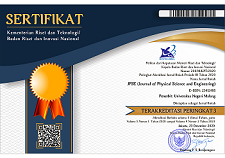The effect of Basic Oxygen Furnace, Blast Furnace, and Kanbara Reactor Slag as Reinforcement to Cement Based Mortar
Abstract
Slag is a waste from steelmaking industries that was released into the environment. Slag was used as reinforced material in mortar. Different types of slag, including Air Cooled Slag (ACS), Granulated Blast Furnace Slag (GBFS), Basic Oxygen Furnace Slag (BOFS), and Kanbara Reactor Slag (KRS), were used as a reinforcing material in this study. The composition of slag in the mixture on mortar was 10%, 20%, 30%, 40%, and 50%. The sample was made with a water-cement ratio (w/c) of 0.35, with the ratio of sand and cement being 1:1.5, respectively. Treatment of mortar sample at ambient temperature was applied. The mortar samples were left to cure until 3, 7, and 28 days, which performed a compression test. The results show that adding slag to the mortar enhanced the compressive strength of the pristine mortar. The highest strength was obtained by adding 10% slag at 28 days. The compressive strength of GBFS, BOFS, KRS, and ACS was 23.76 MPa, 23.28 MPa, 19.68 MPa and 17.48 MPa, respectively. Based on the XRD result, it was discovered that the mixture has more Calcium Silicate Hydrate Peak than Pristine mortar.
Keywords
Full Text:
PDFReferences
S. P. Dunuweera and R. M. G. Rajapakse, “Cement types, composition, uses and advantages of nanocement, environmental impact on cement production, and possible solutions,” Adv. Mater. Sci. Eng., vol. 2018, p. 4158682, 2018, doi: 10.1155/2018/4158682.
A. S. Ouda and H. A. Abdel-Gawwad, “The effect of replacing sand by iron slag on physical, mechanical and radiological properties of cement mortar,” HBRC journal, vol. 13, no. 3, pp. 255–261, 2017, doi: 10.1016/j.hbrcj.2015.06.005.
H. El-Didamony, A. A. Amer, T. M. El-Sokkary, and H. Abd-El-Aziz, “Effect of substitution of granulated slag by air-cooled slag on the properties of alkali activated slag,” Ceramics Int., vol. 39, no. 1, pp. 171–181, 2013, doi: 10.1016/j.ceramint.2012.06.007.
A. Harmaji et al., “Effect of air-cooled slag and granulated blast furnace slag addition as substitutor on fly ash based geopolymer,” In AIP Conf. Proc., vol. 1887, no. 1, 2017, p. 020019, doi: 10.1063/1.5003502.
W. -T. Lin, C. -J. Tsai, J. Chen, and W. Liu, “Feasibility and characterization mortar blended with high-amount basic oxygen furnace slag,” Mater., vol. 12, no. 1, p. 6, 2019, doi: 10.3390/ma12010006.
N. T. Abdel-Ghani, H. A. El-Sayed, and A. A. El-Habak, “Utilization of by-pass cement kiln dust and air-cooled blast-furnace steel slag in the production of some “green” cement products,” HBRC J., vol. 14, no. 3, pp. 408–414, 2018, doi: 10.1016/j.hbrcj.2017.11.001.
H. El-Diadamony, A. A. Amer, T. M. Sokkary, and S. El-Hoseny, “Hydration and characteristics of metakaolin pozzolanic cement pastes,” HBRC J., vol. 14, no. 2, pp. 150–158, 2018, doi: 10.1016/j.hbrcj.2015.05.005.
J. Zapała-Sławeta, “Alkali silica reaction in the presence of metakaolin-the significant role of calcium hydroxide,” In IOP Conf. Ser.: Mater. Sci. Eng., vol. 245, no. 2, 2017, p. 022020, doi: 10.1088/1757-899X/245/2/022020.
S. Singh, G. D. Ransinchung, and P. Kumar, “Effect of mineral admixtures on fresh, mechanical and durability properties of RAP inclusive concrete,” Constr. Build. Mater., vol. 156, pp. 19–27, 2017, doi: 10.1016/j.conbuildmat.2017.08.144.
G. F. Huseien, J. Mirza, M. Ismail, S. K. Ghoshal, and M. A. M. Ariffin, “Effect of metakaolin replaced granulated blast furnace slag on fresh and early strength properties of geopolymer mortar,” Ain Shams Eng. J., vol. 9, no. 4, pp. 1557–1566, 2018, doi: 10.1016/j.asej.2016.11.011.
A. Jan et al., “A review on the effect of silica to alumina ratio, alkaline solution to binder ratio, calcium oxide+ ferric oxide, molar concentration of sodium hydroxide and sodium silicate to sodium hydroxide ratio on the compressive strength of geopolymer concrete,” Silicon, vol. 14, pp. 3147–3162, 2022, doi: 10.1007/s12633-021-01130-3.
J. K. Jang, H. G. Kim, J. H. Kim, and J. S. Ryou, “The evaluation of damage effects on MgO added concrete with slag cement exposed to calcium chloride deicing salt,” Mater., vol. 11, no. 5, p. 793, 2018, doi: 10.3390/ma11050793.
Y. Dhoble and S. Ahmed, “Study on cementitious properties of steel slag by partial replacement of cement,” Glob. J. Eng. Sci. Res., vol. 5, no. 7, pp. 213–220, 2018.
L. Wang, Y. Wei, G. Lv, L. Liao, and D. Zhang, “Experimental studies on chemical activation of cementitious materials from smelting slag of copper and nickel mine,” Mater., vol. 12, no. 2, p. 303, 2019, doi: 10.3390/ma12020303.
A. Saludung, Y. Ogawa, and K. Kawai, “Microstructure and mechanical properties of FA/GGBS-based geopolymer,” In MATEC Web of Conf., vol. 195, p. 01013, 2018, doi: 10.1051/matecconf/201819501013.
M. Karhu et al., “Ferrochrome slag feasibility as a raw material in refractories: evaluation of thermo-physical and high temperature mechanical properties,” Waste and Biomass Valorization, vol. 11, no. 12, pp. 7147–7157, 2020, doi: 10.1007/s12649-020-01092-4.
Ş. Koçyiğit and V. V. ÇAY, “Investigation of mechanical and thermal behavior of basalt cutting waste (BCW) added clay brick,” Europ. J. Tech. (EJT), vol. 9, no. 2, pp. 209–218, 2019, doi: 10.36222/ejt.643209.
N. Cobîrzan et al., “Volcanic tuff as secondary raw material in the production of clay bricks,” Mater., vol. 14, no. 22, p. 6872, 2021, doi: 10.3390/ma14226872.
W. Kunther, S. Ferreiro, and J. Skibsted, “Influence of the Ca/Si ratio on the compressive strength of cementitious calcium–silicate–hydrate binders,” J. Mater. Chem. A, vol. 5, no. 33, pp. 17401–17412, 2017, doi: 10.1039/C7TA06104H.
A. Ramelan et al., “Pengaruh penambahan silica fume, rasio air-semen, dan rasio semen-agregat terhadap kekuatan tekan beton,” J. Metal. Mater. Indones., vol. 1, no. 1, pp. 10–16, 2018.
Copyright (c) 2022 Andrie Harmaji, Andri Hardiansyah, Neneng Annisa Widianingsih, Rodulotum Minriyadlil Jannah, Syoni Soepriyanto

This work is licensed under a Creative Commons Attribution-ShareAlike 4.0 International License.
This work is licensed under a Creative Commons Attribution-ShareAlike 4.0 International License




















